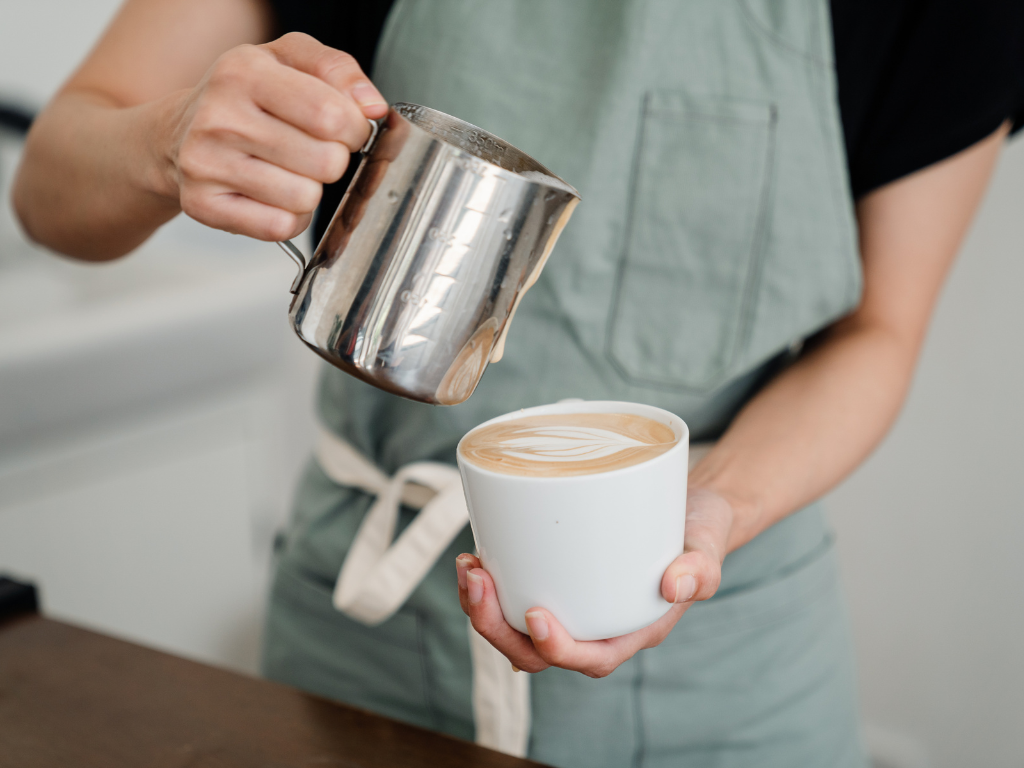A beautifully poured heart or rosette on top of a creamy latte doesn’t just look impressive—it represents the balance between great espresso, well-textured milk, and precise technique. While latte art may seem like a professional barista skill, with the right tools, a little practice, and some patience, you can start creating it right in your own kitchen.
In this guide, you’ll learn the step-by-step process of making latte art at home, including how to steam milk, pour properly, and master simple designs like the heart and tulip—even without a commercial espresso machine.
What is latte art?
Latte art is the design created by pouring steamed milk into a shot of espresso, forming a pattern on the surface. It’s not just decoration—it shows that the milk has been frothed correctly, the espresso has a good crema, and the pour was controlled and intentional.
Common latte art patterns include:
- Heart
- Rosetta (leaf)
- Tulip
- Swan (advanced)
Great latte art requires four things:
- A well-pulled espresso shot with crema
- Microfoam—smooth, velvety milk texture
- A steady, controlled pour
- A little bit of practice and patience
Tools you need for latte art
You don’t need a commercial setup, but a few tools make the process easier:
- Espresso maker or strong espresso-style brewer (e.g., moka pot + milk frother)
- Milk frother with steam wand or handheld frother
- Milk pitcher with a narrow spout (important for precision pouring)
- Whole milk (recommended for beginners due to its fat content and stability)
- Latte cup (wide mouth, around 150–200 ml)
Optional but helpful:
- Digital thermometer (to monitor milk temperature)
- Espresso scale (for consistent shot timing)
Step 1: Make your espresso shot
Use freshly ground beans and aim for a 25–30 second extraction for a rich, balanced espresso with crema.
No espresso machine? You can use:
- Moka pot: use finely ground coffee and strong ratio
- AeroPress: brew a strong shot with 14–18g of coffee and 60–80ml water
- Capsule espresso maker (like Nespresso): convenient but harder to control crema quality
Pour your espresso into a latte cup and get ready to steam the milk.
Step 2: Steam or froth your milk
Latte art depends on microfoam—steamed milk with tiny, uniform bubbles that give it a shiny, paint-like texture.
Ideal milk temperature:
55–65°C (130–150°F)
Hotter than that, and milk can scald, ruining texture and flavor.
Method 1: Steam wand (best option)
- Fill pitcher with cold milk (⅓ full—milk expands)
- Submerge wand just below surface and turn on steam
- “Stretch” the milk by lowering pitcher slightly for a few seconds
- Submerge wand deeper to heat milk
- When the pitcher is warm to touch (or hits 60°C), turn off steam
- Swirl milk to remove any bubbles and create a glossy texture
Method 2: Handheld milk frother + heating
- Heat milk separately in a saucepan or microwave
- Froth with a handheld wand, keeping the tip near the surface
- Let foam settle, then swirl to integrate
- Tap the container on the counter to remove large bubbles
Method 3: French press
- Heat milk
- Pour into clean French press
- Pump plunger vigorously until milk doubles in volume
- Swirl and pour immediately
Step 3: Prepare your pour
Timing is key—pour the milk right after steaming, while it’s still silky and airy. If it sits too long, it separates and becomes harder to control.
- Swirl the milk in the pitcher to keep it uniform
- Hold the cup at a slight angle
- Start your pour from higher up, then move closer for design
Step 4: Basic latte art designs (step-by-step)
1. The Heart
- Start with a steady stream of milk into the center of the cup
- Once cup is half full, lower pitcher and increase flow
- A white circle will appear—keep pouring in the same spot
- Lift pitcher and pull through the circle to form a heart
Tips: Practice pouring speed. Too fast and you lose control; too slow and no shape forms.
2. The Tulip
- Start like the heart, forming a white dot
- Slightly stop pouring, then start a second dot behind the first
- Repeat for a third layer
- Pull through all three dots with a swift, clean motion
Tips: Tulips require good control and foam thickness. Start with just two layers before trying more.
3. The Rosetta (Leaf Pattern)
- Pour a thin stream from 6–8 cm above the cup
- Move the pitcher side to side quickly while slowly moving backward
- This creates layered “leaf” waves
- Once near the edge, pull through the center to complete the leaf
Tips: Rosettas take time to master. Focus on steady hand motion and milk flow.
Troubleshooting common problems
Problem: No shape appears
Fix: Milk may be too foamy or not integrated—swirl more before pouring
Problem: Milk sinks instead of floating
Fix: Wait for crema to settle, or pour more gently
Problem: Foam too thick or bubbly
Fix: Froth for less time or reposition the steam wand
Problem: Milk pours in too fast
Fix: Tilt pitcher less, or narrow your stream
Practice tips
- Use water with a drop of dish soap to practice pouring technique without wasting milk
- Watch slow-motion videos of latte art pours
- Practice steaming milk without over-frothing—you want texture, not stiff peaks
- Focus first on getting the perfect heart before moving to complex designs
Final thoughts: latte art is a ritual, not a race
Latte art is about more than aesthetics—it’s about technique, attention, and enjoying the ritual of coffee-making. You don’t need perfection to impress yourself or your guests. Even a simple heart, well-poured, adds a touch of beauty and care to your daily coffee routine.
So grab your milk, prep your espresso, and start practicing. With time, your home lattes will look as good as they taste.
